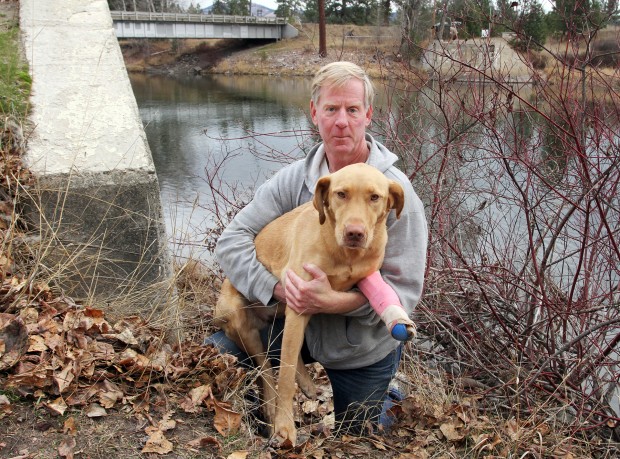For “Mammal Monday”:
Cold Weather Tips
“Brrrr—it's cold outside! The following guidelines will help you protect your companion animals when the mercury dips.
- Keep your cat inside. Outdoors, felines can freeze, become lost or be stolen, injured or killed. Cats who are allowed to stray are exposed to infectious diseases, including rabies, from other cats, dogs and wildlife.
- During the winter, outdoor cats sometimes sleep under the hoods of cars. When the motor is started, the cat can be injured or killed by the fan belt. If there are outdoor cats in your area, bang loudly on the car hood before starting the engine to give the cat a chance to escape.
- Never let your dog off the leash on snow or ice, especially during a snowstorm, dogs can lose their scent and easily become lost. More dogs are lost during the winter than during any other season, so make sure yours always wears ID tags.
- Thoroughly wipe off your dog's legs and stomach when he comes in out of the sleet, snow or ice. He can ingest salt, antifreeze or other potentially dangerous chemicals while licking his paws, and his paw pads may also bleed from snow or encrusted ice.
- Never shave your dog down to the skin in winter, as a longer coat will provide more warmth. When you bathe your dog in the colder months, be sure to completely dry him before taking him out for a walk. Own a short-haired breed? Consider getting him a coat or sweater with a high collar or turtleneck with coverage from the base of the tail to the belly. For many dogs, this is regulation winter wear.
- Never leave your dog or cat alone in a car during cold weather. A car can act as a refrigerator in the winter, holding in the cold and causing the animal to freeze to death.
- Puppies do not tolerate the cold as well as adult dogs, and may be difficult to housebreak during the winter. If your puppy appears to be sensitive to the weather, you may opt to paper-train him inside. If your dog is sensitive to the cold due to age, illness or breed type, take him outdoors only to relieve himself.
- Does your dog spend a lot of time engaged in outdoor activities? Increase his supply of food, particularly protein, to keep him, and his fur, in tip-top shape.
- Like coolant, antifreeze is a lethal poison for dogs and cats. Be sure to thoroughly clean up any spills from your vehicle, and consider using products that contain propylene glycol rather than ethylene glycol. Visit the ASPCA Animal Poison Control Center more information.
- Make sure your companion animal has a warm place to sleep, off the floor and away from all drafts. A cozy dog or cat bed with a warm blanket or pillow is perfect.”
_______
Dolphins, and others, have been dying in the northern Gulf of Mexico
“In the two and a half years since BP's oil disaster sent over 200 million gallons of oil into the Gulf, unprecedented numbers of dolphins have been dying in the northern Gulf of Mexico; and many are suffering from symptoms that suggest oil exposure.
Yet, even after pleading guilty to criminal charges for the oil spill, BP has vowed to vigorously contest the charges it is facing under federal environmental law--even though money from these fines will be used to restore the Gulf.

The dedicated efforts of hundreds of thousands of wildlife advocates like you led to Congress passing legislation earlier this year that ensures BP's fines for the oil spill will go to restoring the Gulf, but now we need to make sure that those payments are substantial enough to do the work that needs to be done in the Gulf for dolphins, sea turtles, and many more wildlife.
BP and the Department of Justice could reach a settlement on their environmental fines as soon as next week, so it's important that we do as much as we can now to raise the voice for dolphins in the Gulf. “
“Your support today will go towards efforts to increase public pressure on the U.S. Department of Justice to force BP to pay the maximum fines for the wildlife and environmental damage they inflicted on the Gulf. https://online.nwf.org/site/Donation2?20781.donation=form1&idb=147038274&df_id=20781”
______
2010-2012 Cetacean Unusual Mortality Event in Northern Gulf of Mexico
“Under the Marine Mammal Protection Act of 1972 (as amended), an Unusual Mortality Event (UME) has been declared for cetaceans (whales and dolphins) in the northern Gulf of Mexico (Texas/ Louisiana border through Franklin County, FL) from February 2010 through the present.
Note: These numbers are preliminary and may be subject to change. As of November 25, 2012, the UME involves 801 Cetacean "strandings" in the Northern Gulf of Mexico (5% stranded alive and 95% stranded dead).” More at: http://www.nmfs.noaa.gov/pr/health/mmume/cetacean_gulfofmexico2010.htm
_______
Dogs Jumping on Guests
“The holiday season can be very busy for many, stressful for some and festive for all. It can be a time of the year when you have more guests coming over to visit. So NOW is the time to get your dog’s jumping under control.
Jumping, depending on your dog’s size, can injure someone, make their cloths dirty or just irritate a friend or family member.
Here is something you may not know about jumping. Jumping is such a strong behavior that there is no one single technique that works on every dog except for this:
What I am about to share with you WILL work on every single dog that
jumps. Would you like to know what it is? Here tis: Do you remember the M.U.T.T. Method that I developed to help dog owners? The acronym stands for Manage, Underlying, Train and Time.
If you have someone come over your house and you have a leash on your
dog and that leash is secured to something very sturdy, it will allow you to invite your guests into the house but your dog will not have access to your guests. This will prevent your dog from jumping on your friends as they come into the house.
Managing behavior is always step one when you have a behavior problem.
The next step is to find out what the underlying problem is and then train
another behavior.
Lastly you need to give it some time for the behavior to kick in.
Put it all together and you have the M.U.T.T. Method which can help with
ANY behavior problem.” Eric.
________
New Texas law regulates animal breeders
![images[9] images[9]](https://blogger.googleusercontent.com/img/b/R29vZ2xl/AVvXsEj60e7BjgMSlV7GBmiCO2jtTKdhGvmi3dnHQdQqOshsZqEydJXGYImX92ONydbu6lxC09GsSHxhvsOtYwCLACLYQAilkWTMolSP_hU5wYBRxnC5xru3-gOa0JG4Kd1qFe0rsUYjxAVrLS9q/?imgmax=800) Goal is to eliminate dangerous, unsanitary puppy mills
Goal is to eliminate dangerous, unsanitary puppy mills
SAN ANTONIO - “A new law aimed at shutting down puppy mills in Texas has state regulators inspecting animal breeders and warning consumers.
Puppy mills have long been blamed for causing animals to suffer and die because of over-breeding and poor sanitary conditions.
In Giddings, Texas, an operation called Little Bit of Heaven was raided by authorities earlier this year. The Humane Society of the U.S. helped rescue 52 dogs, finding them in small wire cages stacked on top of each other in deplorable conditions.
"The only way that we knew about it was because consumers were complaining that they were purchasing sick and dying puppies," said Katie Jarl, the Texas state director of HSUS. But she said a new Texas law that regulates dog and cat breeders should cut down on puppy mills.”” More and VIDEO at: http://www.ksat.com/news/defenders/New-Texas-law-regulates-animal-breeders/-/478436/17472320/-/15it94bz/-/index.html
Now you can ask if a breeder has a TX State Breeders Certificate.
---------
From Me: Maybe we can get all these cruel puppy mills eliminated.
LA City Council Approves Ban To Keep Stores From Selling Breeder Pets
 LOS ANGELES (CBSLA.com) — “Los Angeles City Council approved a ban that would keep stores from selling commercially bred dogs, cats or rabbits.
LOS ANGELES (CBSLA.com) — “Los Angeles City Council approved a ban that would keep stores from selling commercially bred dogs, cats or rabbits.
Councilman Paul Koretz said he introduced the ban to reduce the number of animals that LA euthanizes each year. The intention is also to shut down puppy and kitten mills. Los Angeles euthanized more than 21,000 dogs, cats and rabbits in each of the past two years — almost 40 percent of the animals in shelters. The law goes into effect in six months. Pet lovers will still be able to buy animals directly from breeders.” More at: http://losangeles.cbslocal.com/2012/10/31/la-city-council-approves-ban-to-keep-stores-from-selling-breeder-pets/
_______
Beware of Traps.

Pete Ramberg and his dog Monte returned to the Florence Bridge Fishing Access Site Tuesday to look at the spot where the dog’s paw was caught in a trap Monday. “I can’t believe that someone would set a trap in a place that is so popular with dog owners,” Ramberg said.
HAMILTON – “A Florence man has pleaded guilty to setting an illegal trap at the Florence Bridge Fishing Access Site that caught a dog last week.
Juan Lopez, 59, was charged with a misdemeanor count of failing to obtain permission to set a trap at the state-owned fishing access site. On Monday, Ravalli County Justice of the Peace Jim Bailey sentenced Lopez to a $535 fine and required the trapper to pay restitution for veterinarian bills for the dog that was caught in his trap.
Lopez also lost his trapping privileges for three years. He is required to complete a certified trapper training course before obtaining his trapping his license in the future.”
______
Is Your Pet Getting Too Much Dietary Fiber... or Not Enough?
“Dietary fiber is defined as complex carbohydrates that are resistant to digestive enzymes in the gastrointestinal tract.
When most people think of fiber, they think of plant fiber. However, the fur, bone, cartilage, tendons and ligaments of prey animals also function as fiber in the intestine of wild canines and felines, and recent research indicates this type of fiber is especially beneficial for cats.

Many commercial pet foods contain entirely too much biologically inappropriate fiber. Other foods, including some raw food diets, can contain too little.
There are several natural ingredients you can add to your pet’s diet – no matter what type of food you feed – to increase fiber content.” Complete article at: http://healthypets.mercola.com/sites/healthypets/archive/2012/11/19/dietary-fiber.aspx
______
Dogs at Work Can Alleviate Employee Stress, Study Shows

“A recent study indicates pet owners who bring their dogs to work have less stress throughout the day than pet owners whose dogs are at home, and non-pet owners.
Employees with dogs at home experience increasing levels of stress during the workday as the number of hours their pet has been left alone piles up.
Researchers preliminarily concluded dogs in the workplace might alleviate the effects of stress for their owners, and may also contribute to higher job satisfaction for all employees in the organization, regardless of dog or pet ownership.
Because not all employees appreciate the presence of dogs in the workplace, it’s important for employers contemplating allowing pets at work to set guidelines and remain sensitive to the needs of non-pet owning workers. Otherwise, dogs in the workplace could actually increase the general stress level among employees.” More at: http://healthypets.mercola.com/sites/healthypets/archive/2012/11/26/dogs-at-work.aspx
_______
On This Day:
Illinois becomes the 21st state, Dec 3, 1818:
“Illinois achieves full statehood on this day. Though Illinois presented unique challenges to immigrants unaccustomed to the soil and vegetation of the area, it grew to become a bustling and densely populated state.
The strange but beautiful prairie lands east of the Mississippi and north of Lake Michigan presented a difficult challenge to the tide of westward-moving immigrants. Accustomed to the heavily forested lands of states like Kentucky and Tennessee, the early immigrants to Illinois did not know what to make of the vast treeless stretches of the prairie. Most pioneers believed that the fertility of soil revealed itself by the abundance of vegetation it supported, so they assumed that the lack of trees on the prairie signaled inferior farmland. Those brave souls who did try to farm the prairie found that their flimsy plows were inadequate to cut through prairie sod thickly knotted with deep roots. In an "age of wood," farmers also felt helpless without ready access to the trees they needed for their tools, homes, furniture, fences, and fuel. For all these reasons, most of the early Illinois settlers remained in the southern part of the state, where they built homes and farms near the trees that grew along the many creek and river bottoms.
The challenge of the prairies slowed emigration into the region; when Illinois was granted statehood in 1818, the population was only about 35,000, and most of the prairie was still largely unsettled. Gradually, though, a few tough Illinois farmers took on the difficult task of plowing the prairie and discovered that the soil was far richer than they had expected. The development of heavy prairie plows and improved access to wood and other supplies through new shipping routes encouraged even more farmers to head out into the vast northern prairie lands of Illinois.
By 1840, the center of population in Illinois had shifted decisively to the north, and the once insignificant hamlet of Chicago rapidly became a bustling city. The four giant prairie counties of northern Illinois, which were the last to be settled, boasted population densities of 18 people per square mile. Increasingly recognized as one of the nation's most fertile agricultural areas, the vast emptiness of the Illinois prairie was eagerly conquered by both pioneers and plows.”
______
First human heart transplant, Dec 3, 1967:
“On December 3, 1967, 53-year-old Lewis Washkansky receives the first human heart transplant at Groote Schuur Hospital in Cape Town, South Africa.
Washkansky, a South African grocer dying from chronic heart disease, received the transplant from Denise Darvall, a 25-year-old woman who was fatally injured in a car accident. Surgeon Christiaan Barnard, who trained at the University of Cape Town and in the United States, performed the revolutionary medical operation. The technique Barnard employed had been initially developed by a group of American researchers in the 1950s. American surgeon Norman Shumway achieved the first successful heart transplant, in a dog, at Stanford University in California in 1958.
After Washkansky's surgery, he was given drugs to suppress his immune system and keep his body from rejecting the heart. These drugs also left him susceptible to sickness, however, and 18 days later he died from double pneumonia. Despite the setback, Washkansky's new heart had functioned normally until his death.
In the 1970s, the development of better anti-rejection drugs made transplantation more viable. Dr. Barnard continued to perform heart transplant operations, and by the late 1970s many of his patients were living up to five years with their new hearts. Successful heart transplant surgery continues to be performed today, but finding appropriate donors is extremely difficult.”
______
Yesterday:
Once again, we couldn’t work on Ray’s floor repair, as he wasn’t going to be home, so Misty and I went to get Jay so that he could clean my carpets.
Lil Miss, the mechanic’s dog, arrived for a bath, and Jay brought Maddie, the little Yorkie, as he wanted me to bathe her, too.
I had picked up all the little furniture out of the way, so Jay got my shampooer from the attic, and shampooed my carpets, while I worked in the grooming room. Jay and I had our usual argument about him putting soap in the carpet shampooer. It already has some spot cleaner on it that I use from time to time, so it just needs a good rinse.
“The best way to clean carpet is to skip putting the shampoo into the carpet shampooer and fill it with plain old water instead. Cleaning with water will not only get your carpet clean, but will also keep it cleaner longer. When you use soap to clean carpet, you fall victim to soap's double-edged sword: it works because dirt molecules bind to soap molecules. That's great news when you're trying to remove dirt from the carpet, but soap molecules stay in the carpet long after you're done cleaning, and they continue to trap dirt right where you don't want it. So try skipping the soap. The following steps show you how.” From: http://www.howtocleanthings.com/floors/how-to-clean-carpet.htm
Jay didn’t remember that the times my carpet looked it’s brightest for the longest was when we just put a little Borax, or vinegar in the water. His memory has been addled by all the beer he drinks. He used to work for a carpet cleaning company, and they want it to go dingy after a while for repeat business. Anyway, theirs has a better water extractor.
We both finished about the same time, so I could take the bathed dogs home when I took Jay home. I left all the chairs, small tables etc. up off the carpet for the rest of the day.

 Map of Strandings
Map of Strandings
















No comments:
Post a Comment